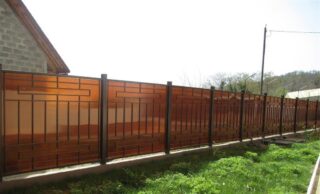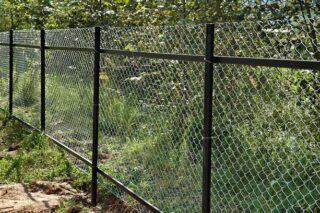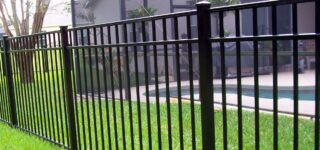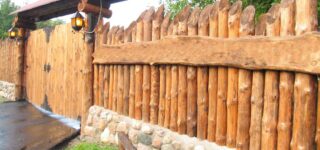The fence is necessary for fencing the land and buildings, surveying. The fence decorates the house, makes it unique, or fits into a number of similar buildings. Fences for a private house differ in purpose, material of manufacture, design features, and construction requirements.
What you need to know before installing a fence

Home ownership of a country house is fenced in in accordance with the norms for the placement of objects. In garden and horticultural societies, it is forbidden to build opaque fences for a house between neighboring plots. To begin with, we study the legal requirements, norms for the installation of fences. Allowable distances to buildings depend on the type and materials of the building. It is not out of place to learn about permits for the construction of a structure.
Before the stage of the project, it is required to draw up a scheme, coordinate with neighbors.
- The location of the fence on the border of the plots is clearly stipulated.
- An act is drawn up with a plan of the bordering areas, on which the fences are marked.
- The act specifies the place of installation, height, material of manufacture.
- The act, after being signed by the neighbors, is coordinated with the cadastral engineer.
This act is a reinsurance in case of litigation. If it was not possible to agree with the neighbors, contact the surveyors. They will provide a geodetic survey, a cadastral plan of plots, so as not to go beyond their territory. If the site is in an urban environment, it is worth visiting the architecture department to find out possible restrictions - suddenly, backbone networks have been laid along it.
During construction, the possibility of a fire truck's entrance is taken into account.
Before you put the fence, pay attention to the soil, the bearing surface. Heavy loam or clay is prone to bulging, so a reliable installation method should be selected. This is important for the construction of heavy fences with plinths.
The choice of the type of fence depends on the climate, terrain. In the area of strong winds, a ventilated fence or a blank one on a solid foundation is preferable. Sailability leads to the need for frequent installation of support pillars.
Features and purpose of the design

The design can be solid, ventilated, shutter fence:
- The deaf option is safer, but impairs the view, shades the plants.
- The ventilated enclosure resembles a lattice or is assembled from modular elements. The plot is ventilated, illuminated, but the territory is visible from the outside.
- The jalousie fence option combines the advantages of blind and ventilated structures. Inclined lamellas keep ventilation and area lighting. The level of privacy is high. The adjacent territory is visible from the inside. The reliability of blinds made of iron is not lower than that of solid metal.
Fence installation purpose:
- designation of the border of the property;
- protection from animals, penetration of unwanted guests;
- preservation of the overview;
- reduction of road noise;
- decrease in wind strength;
- hindering the invasion, complicating the removal of property;
- decorative fencing to emphasize the unity of style with the house;
- zoning of the inner territory;
- protection of small children, animals.
Based on the specifics of the purpose, legislative acts, the material, method of execution, height, strength are determined.The specificity of the soil is taken into account: sometimes the fence may not be suitable for the bearing capacity of the soil.
Primary requirements

The main requirement is related to regulations, legislative codes for a specific type of settlement.
The documentation is reviewed by the town planning organization. The standards for fences and barriers for a private house and a summer cottage differ. You should review the legislative acts and building rules in advance.
The following general requirements are imposed on fences between adjacent areas:
- The height of the fence between neighbors is up to 1.5 m. Opaque - no higher than 75 cm.
- It is forbidden to install a high blank fence, which reduces the ingress of sunlight;
- To strengthen the structure, it is allowed to manufacture a combined fencing.
- The fence should be strong, safe, with a minimum of sharp elements.
- If the thickness of the fence to be installed is more than 5 cm, the building is erected on the owner's territory.
- The construction of a hedge is possible with the consent of the neighbors.
The structure should be beautiful, lightweight, economical, aesthetic and safe.
There are no special regulations for fencing IZHS buildings. But the rules and regulations can be deducted in the SNIP. SNiP 30-02-97 is used as a basis. Municipalities repeat the text to some extent.

Requirements for the construction of external fences:
- Height - up to 220 cm. Tall structures prevent street lighting at night.
- The use of "blind" structures is allowed.
- The fence must be safe for passers-by. It is forbidden to use "fidget", barbed wire at the height of human growth. Sharpened elements are directed upward or into the territory.
- Installation of a strip foundation requires wastewater disposal, drainage.
- The gate opens inward if the passage area is less than 1.5 meters. Otherwise, it will interfere with the passage of pedestrians.
- The fencing palette is agreed with the local administration.
The distance between the fence and buildings is at least 1 m. The distance to buildings with animals, large trees is at least 4 m; bushes, small trees - 1 m.
The issues of fire safety of buildings are spelled out in the SNIP. Depending on the type of fence material, the distance to non-combustible materials is 6 m, wooden ones - 15 m, combined with combustible, non-combustible materials - 8 m.
Material for making hedges

There are a lot of materials for making a fence.
- Euroshtaketnik. Stamped items made of thin sheet metal like a wooden picket fence. They are fastened in the same way on wooden or metal joists. A wide range of colors, durability, ease of installation are the main advantages of this lattice fence.
- Polycarbonate. It is a semi-transparent material with flexural strength, with different colors. With the help of it, you can originally equip the territory. The material is impervious to moisture, mold, corrosion, and weather resistant. Its flexibility allows the construction of products of unusual shapes. Low cost, lack of maintenance are especially valuable. Combines with metal, stone, brick, wood.
- Rabitz. Such material has a low cost, it can be installed without the involvement of specialists. The easiest option is to hang the mesh on a supporting wire. More complicated and more aesthetically pleasing is putting it into a metal frame. For manufacturing, use galvanized options.
- Wooden picket fence. The most common, simple, budget material in central Russia and beyond the Urals. This is a classic for inexpensive holiday villages. Such a structure is easy to make yourself with a minimum of effort. The most common manufacturing option is to mount a vertical picket fence on horizontal logs. High environmental friendliness is appreciated when decorating garden plots.
- Concrete.Fences made of this material are durable, serve for decades without destruction. Now decorative forms are used that make such hedges light, airy, at first glance. They can be cast in the form of a brick wall, in a colonial style, or in other unusual shapes. The cost is relatively low, since it does not require special skill in manufacturing and installation. Installation is quite simple, unlike brick fences. The product reliably protects the territory. Color pigments are added to modern reinforced concrete slabs to color the product in all colors of the rainbow.
- Brick and stone. In the manufacture of often taken shell rock, sandstone or one of the types of local stones. Used rubble and basalt rocks. The main advantages: thermal stability, rich appearance, resistance to mechanical damage, a period of operation up to 100 years. Of the minuses is the heaviness of the product. Such fences require a separate foundation and are classified as capital structures. The high cost of the material, the laboriousness of laying out, restrain the widespread use of such barriers.
- Metal corrugated board. These products are considered versatile. They are appreciated for quick installation, decent appearance, wide range of colors. Sheets are mounted on metal or brick posts. Durable sheet options start at 0.4mm thick. The fence is characterized by heat resistance, high strength, long service life. The solid construction perfectly protects from the wind, prying eyes from the street. However, the aesthetics of the product is low. Moreover, it is easily damaged mechanically.
Often, improvised materials are used for construction: branches, plastic bottles, clay pots, firewood, logs, stumps, plastic pipes. At the metal warehouse, you can collect bicycle frames.
Options for hedges for a private house and summer cottage
A country fence is often installed on the site in an economy version. It can be a profiled sheet, metal or wooden picket fence, polycarbonate, various types of nets, rods, boards. Products made from such materials are quite economical and budgetary. Swing or sliding gates are made of the same material.

In a private house, reliable monumental structures of a high class are most often installed:
- Long-lasting concrete fence.
- Brick high building.
- Plastic fence made of designer materials.
- Welded protection from a metal profile pipe.
- Forged products on metal or stone pillars. To reduce transparency, colored polycarbonate is often added to match the color of the polymer. Forged products are expensive, so the modern variety is pseudo-forged products from a pipe bent on a machine.
- The wooden fence is environmentally friendly. Different manufacturing options: checkerboard weaving, ladder, herringbone, blinds, picket fence vertically and horizontally diversify the appearance of the fence. To protect against moisture, it is necessary to treat it with impregnations and it will last more than ten years. Also, wooden barriers are used in the form of a wattle fence, palisade, lattice.
- Ranch-style hedges are becoming more and more popular. This type of fencing protects only from the entry of large animals, exposing all the beauty of the house.
- Stone structures require a solid foundation and skill in laying. The most common is facing with finishing bricks. Less often - chipped, clinker, ceramic, silicate, hyper-pressed. Such a fence is durable, it allows you to stylishly decorate the facade of the site. Stone hedges include the manufacture of limestone, artificial stone, cobblestone. The latter is extremely durable and maintenance-free.
If the owner does not like artificial materials, it is permissible to plant hedges. They are used to delimit areas, framing flower beds, gazebos. They are evergreen or deciduous.The main disadvantage of such fences is the need for constant maintenance, pruning, and the undesirability of planting from the front side.
Fence for a house in a modern style

A beautiful fence for a country house forms the first impression of home ownership and its owner. The choice of the fence should take into account the aesthetic properties of the material, functionality.
In addition to protecting the territory, the material of the fence should harmoniously fit into the landscape of the site, be combined with the decoration of the house.
A wooden fence made of a palisade or a log of an eurofence will correspond to a log house in the Russian style. A colonial-style stone house will look good with wrought iron gratings, concrete carved slabs. A traditional brick house will be favorably emphasized by a stone, brick fence with inserts made of metal, plastic, polycarbonate.
Wood is a polyvariate material. With the help of various mounting techniques, the die can be adapted to almost any type of home decoration.
The version of the "Australian braid" looks elegant and unusual. Install it horizontally or vertically. Such a fence looks the same on both sides, visually correcting the unevenness of the landscape.
The latest squeak of fashion is products from "liquid wood". The crushed sawdust is mixed with plasticizers and molded. As a result, the board takes on the appearance of a painted wood, acquiring the positive properties of plastic: water resistance, resistance to mold, fungi, fire safety, long service life.
Stone houses look great with pergons, gabions, gray profiled sheet inserts. Polymer fences are often decorated with photo printing on plastic film or a banner. This is the best way to hide the defects of long-term use of the surface.








